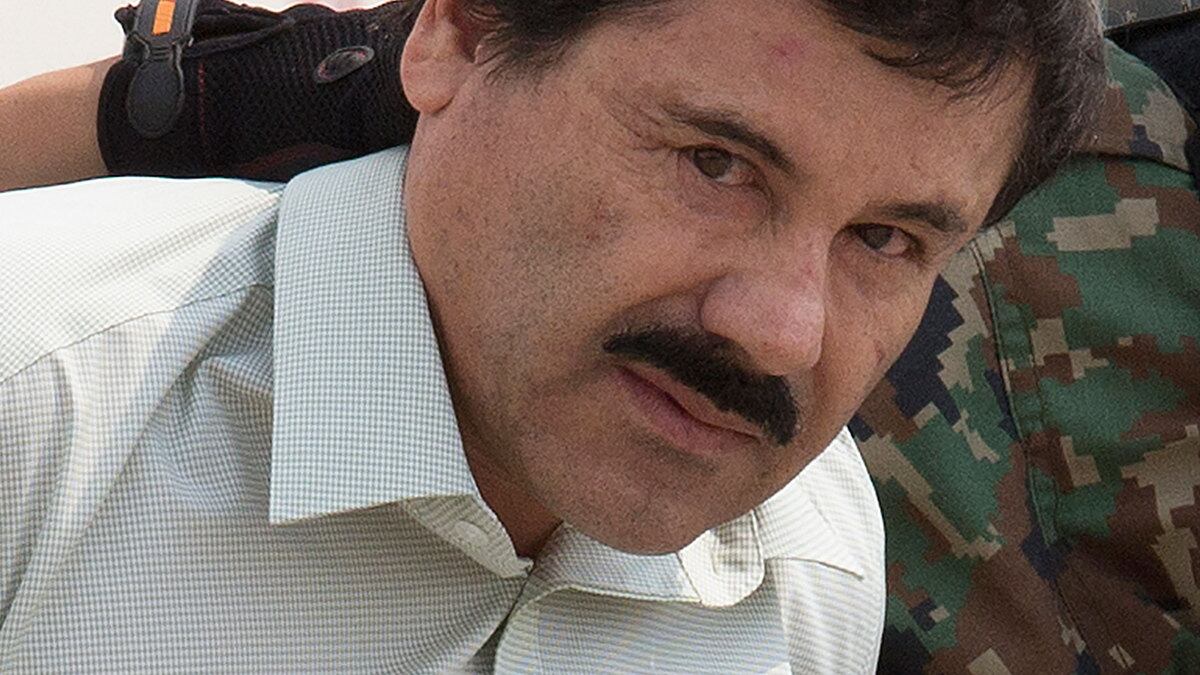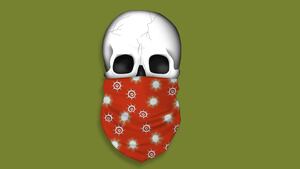It’s a hot and sunny day in mid-April 2019, and I’m sitting in the passenger seat of a borrowed Honda Pilot SUV driven by Miguel Ángel Vega, a jovial reporter born and raised in Culiacán. We’re on our way to La Tuna, the birthplace of El Chapo, and like many of the towns and villages in these parts, it is not an easy place to get to. For people who don’t want to be found, that’s what makes it such a good place to hide. Driving along the twists and turns of Highway 24 as it hugs the curves of the hillsides, I can see why Sinaloans pride themselves on autonomy: in a place this remote, you can’t look to the outside world for help.
As I was about to find out, they take matters of security into their own hands out here.
It’s an hour just to get from Culiacán to the municipal capital of Badiraguato, a town of about 3,700 people that spreads out on either side of the highway, which forms a main drag through town. Crossing the last bridge on the way out of Badiraguato, our cell phones lose service, and we drive for another hour up the highway before our next turn. Miguel Ángel and I pass the time chatting about the job, him quizzing me on my experience reporting on El Chapo’s trial and me asking him questions about the area, obscure figures in the drug trade, his life reporting on the violence in his hometown. It’s early afternoon now, and I’m forced to reapply sunscreen to my skin, still pale from winter in New York, and eventually I drape a spare shirt over my right arm to keep it from burning in the sun. Finally we come to the turnoff that will lead to La Tuna. This is where we hit the first checkpoint.
Miguel Ángel eases his foot off the gas and cuts the wheel left to turn onto a narrow dirt track headed off the highway and deeper into the mountains. By the side of the road, lounging in the shade of a tree, three men sit cradling AK-47-style rifles. As we pull up, they go bolt upright and eye us with sudden attention. A few feet away up a slight hill, a fourth man hops out of the cab of a bulldozer, an AK in one hand and a walkie-talkie in the other. With the walkie-talkie hand, he waves at us to stop, as his pals get to their feet. Apart from the tactical vests that hold extra magazines of ammo, all four men are dressed in street clothes. These men are not soldiers, and they’re not cops, although they might be the closest thing to cops or soldiers around here.
The lead gunman appears to be in his late twenties, his arms covered in tattoos. Gripping the AK by its distinctive curved magazine—referred to in Mexico as a cuerno de chivo, or goat’s horn—he keeps the muzzle pointed at the ground as he strolls up to the passenger-side window and motions for me to roll it down.
He wants to know who we are, what we’re doing there. Do we have permission to be there?
I’m not sure how to respond.
When Miguel Ángel picked me up at the airport twenty-four hours earlier, the first thing he told me was the importance of being honest with these guys: as long as you’re straight with them, they’ll be straight with you. If you tell the truth, you don’t have to worry. Miguel Ángel should know. After working for years as a journalist in Culiacán for the local weekly paper Riodoce (and a stint directing movies), he now makes his living as a “fixer,” driving international reporters around the state setting up interviews with all manner of shady characters. Around here, he’s the best in the business, and does a brisk trade as one of the only reporters with the contacts necessary to gain access to La Tuna.
When the gunman asks me if I speak Spanish, the first thing that comes out of my mouth is a lie.
“No,” I say, feigning a look of regret.
My heart is pounding. Although I had known we might come across checkpoints like this, and I had heard stories of other reporters being turned away, Miguel Ángel and I have not discussed what I should say in such a situation. It seems wise to let him do the talking.
After giving me a hard stare for a moment, the gunman turns to Miguel Ángel and asks him who we are, if we’re journalists. In a cheerfully deferential tone, Miguel says that yes, we’re reporters, but explains that we’re just here to see a friend.
Not a lie! Over the years, Miguel Ángel has cultivated a relationship with our host, an evangelical Christian who lives and raises cattle in La Tuna, just a short walk from the home of El Chapo’s mother, and who graciously hosts Miguel Ángel and his rotating cast of guests.
“He’s expecting us, ask them on the radio,” Miguel Ángel tells the gunman with the tattoos and the hard stare.
Without taking his eyes off us, the young gunman takes a step back and mutters something into the radio. After a moment, he receives an answer that seems to satisfy him. He turns to me again, nearly blinding me with his gaze.
“¿Cómo te llamas?” he asks. “What’s your name?”
Although I’ve been following the conversation fine, I perk up at this, as if the question is the first thing I understand, a relic of some Spanish 101 class in high school, and answer like I’m proud to pass a test.
“Noah, me llamo Noah,” I chirp with only partially feigned relief, heart still racing.
The gunman gives me a close look, as if trying to determine if I’m lying.
“Okay,” he says finally, with a raise of his eyebrows. After one more squint for good measure, he waves us along.
Miguel Ángel waves at the men as we pass. I dig into my backpack, pull out a pack of cigarettes, and light one, taking a long drag in relief.
“Dude,” Miguel Ángel says happily, “were you so fucking scared?”
A few months later, during my second trip to Sinaloa, I found myself in a half-empty coffee shop in Culiacán, stammering out questions to a guy named Beto. It was late, nearly 10 p.m., and the staff were eyeing us in hopes that we’d clear out so they could close up shop for the night. I was exhausted as well. Working with my fixer, a local reporter named Miguel Ángel Vega, I’d already done three or four hours of interviews that day, all in Spanish. My Spanish is OK, but it takes all the concentration I can muster to follow along and ask follow-up questions, and by the end of a day like that one, I was half-delirious, ready to drop. So when Beto and his two bodyguards strolled into the cafe, all tight jeans, polo shirts, flat-brim caps, and a lazy air of coiled menace around them, I was not only dead tired but also a little intimidated. They sat down and muttered darkly that they’d seen some men in the parking lot outside, didn’t like the looks of them, and had waited until they left. That’s why they were late.
At Beto’s request, we moved from the table by the window where Miguel Ángel and I had been sitting to another one farther inside, so Beto could have his back to the wall. A few minutes later it became clear that the interview wasn’t going well; it was my fault, and Beto seemed mildly annoyed. Shifting occasionally around in his seat, he looked uncomfortable, and during one of these fidgets I saw why, as he tugged the hem of his black polo shirt down to cover the handle of the semi-automatic pistol sticking out of his waistband.
He said he was a nephew of El Chapo, but that’s a vague term, and I figured he was probably more like a distant cousin. Still, he knew El Chapo better than almost anyone else I’d spoken with and was particularly familiar with El Chapo’s later years. Raised in the tiny village of Nogalito, a few miles from El Chapo’s hometown of La Tuna, he worked closely with El Chapo, first as part of his security entourage and later as a pilot. I asked him something stupid: “Did you know your uncle well?” and he responded with a hint of mockery in his voice.
“I should,” he said with a smirk. “I practically slept in the same bed as him every night.”
I laughed nervously and tried to come up with a response, or at least my next question, but before I could do so, Beto looked up from his phone and locked eyes with me.
“I have a question for you,” he said. “Why do gringo journalists always want to come here to Sinaloa to ask about drugs?”
Good question.
The only other gringos I ran into in Culiacán during all of my trips there was a film crew working on a documentary, and it was no coincidence that I ran into them at the shrine to Jesús Malverde—a local folk hero in the tradition of Robin Hood. The shrine seems to be a required stop on the “narco tours” of Sinaloa that reliably shows up in nearly every book or documentary on the region. You know the ones: a tough host whispering to the camera about the danger he’s in, wondering if this pedestrian or that street juggler is a halcón, or falcon, the term for a cartel lookout; the masked dealers speaking in digitally altered tones near piles of drugs and weapons.
I came to Culiacán to do something different. I knew that El Chapo’s story needed to be cast in a more nuanced light, offering a better understanding not just of his exploits but of the place he came from, the time in history he inhabited, the forces of prohibition and foreign policy that shaped the drug trade and helped make him wealthy and left tens of thousands of Mexicans dead and tens of thousands more disappeared.
But sitting there next to Beto, I didn’t know how to articulate that. I know better now, and I wish I could have explained myself to Beto. Here was a rough man, almost certainly with blood on his hands, asking me a simple question without malice or mockery. Why was I here in Culiacán, asking him questions about his uncle?
In response, I stammered something corny about finding the truth, telling the story of El Chapo, explaining how the opioid crisis was ravaging communities in the United States and it was important to understand where the drugs came from and what motivates the people here to send the drugs north. But I could tell Beto wasn’t satisfied with my answer. I wasn’t satisfied with my answer.
In the end, I never got the second interview with him; I never got to answer his question. A month or so after we first met, I was standing in the kitchen of my apartment in Mexico City, about to go for a walk with a friend, when my cell phone rang: it was Miguel Ángel. We’d been discussing plans for an upcoming trip to Sinaloa, which was to be my third. Among other meetings, I’d been pestering him to get me in touch with Beto again, to give me a chance to do a more thorough interview after blowing it the first time. But when I picked up, Miguel Ángel’s voice sounded different, strained, stressed out.
“Dude, they fucking killed Beto,” Miguel Ángel said in Spanish. “Beto’s dead.”
Excerpted from El Chapo published by Atria, a division of Simon & Schuster, Inc. Copyright © 2021 by Noah Hurowitz.







